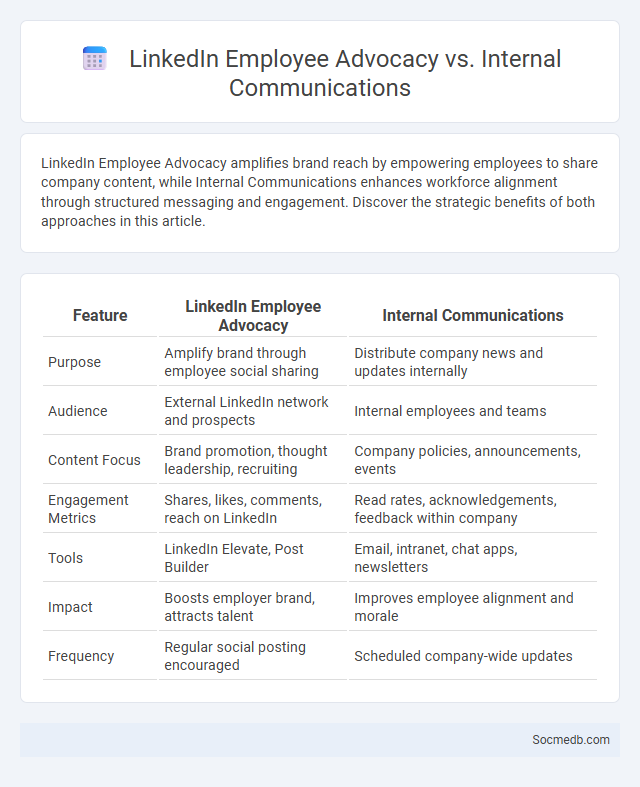
Photo illustration: LinkedIn Employee Advocacy vs Internal Communications
LinkedIn Employee Advocacy amplifies brand reach by empowering employees to share company content, while Internal Communications enhances workforce alignment through structured messaging and engagement. Discover the strategic benefits of both approaches in this article.
Table of Comparison
| Feature | LinkedIn Employee Advocacy | Internal Communications |
|---|---|---|
| Purpose | Amplify brand through employee social sharing | Distribute company news and updates internally |
| Audience | External LinkedIn network and prospects | Internal employees and teams |
| Content Focus | Brand promotion, thought leadership, recruiting | Company policies, announcements, events |
| Engagement Metrics | Shares, likes, comments, reach on LinkedIn | Read rates, acknowledgements, feedback within company |
| Tools | LinkedIn Elevate, Post Builder | Email, intranet, chat apps, newsletters |
| Impact | Boosts employer brand, attracts talent | Improves employee alignment and morale |
| Frequency | Regular social posting encouraged | Scheduled company-wide updates |
Understanding LinkedIn Employee Advocacy
Understanding LinkedIn employee advocacy involves leveraging your workforce to amplify your brand's reach, credibility, and engagement on the platform. By encouraging employees to share company content and their professional experiences, organizations can increase trust among potential clients and industry peers. Your strategic support of employee advocacy on LinkedIn can boost organic visibility and drive meaningful business opportunities.
Defining Internal Communications
Internal communications in social media refer to the strategic sharing of information and messages within an organization using social platforms and digital tools. These communications enhance employee engagement, facilitate collaboration, and ensure alignment of company goals across departments. Effective internal social media strategies leverage real-time feedback, targeted messaging, and multimedia content to boost transparency and productivity.
What Is Employee Advocacy?
Employee advocacy is the promotion of an organization by its staff members through their personal social media channels, amplifying brand reach and credibility. This strategy leverages employees' authentic voices to enhance corporate reputation, increase engagement, and attract potential talent. Companies with active employee advocacy programs see a significant boost in social media impressions, brand trust, and recruitment success.
Differences Between LinkedIn Employee Advocacy and Internal Communications
LinkedIn employee advocacy leverages your workforce to promote company content externally, enhancing brand visibility and trust through authentic employee voices. Internal communications focus on distributing information within the organization to strengthen engagement, alignment, and culture among employees. Understanding these differences helps tailor strategies that maximize both external influence and internal cohesion for your business.
Overlapping Goals: Where Advocacy and Internal Comms Meet
Social media platforms facilitate overlapping goals where advocacy efforts and internal communications converge, enhancing organizational transparency and employee engagement. By leveraging targeted content strategies, companies amplify their advocacy messages while fostering a collaborative internal culture. Effective integration of these communication streams drives unified branding and strengthens stakeholder trust across all channels.
Benefits of LinkedIn Employee Advocacy Programs
LinkedIn Employee Advocacy Programs amplify your brand's reach by turning employees into trusted ambassadors, increasing engagement and credibility among target audiences. These programs foster authentic content sharing, driving higher lead generation and strengthening customer relationships. Empowering employees to promote your company on LinkedIn enhances visibility, talent attraction, and overall business growth.
Impact of Internal Communications on Company Culture
Effective internal communications significantly influence company culture by fostering transparency, trust, and employee engagement across social media platforms. Companies leveraging social media for internal communication report higher collaboration rates, stronger alignment with organizational values, and increased employee satisfaction. Research indicates that clear, consistent messaging through internal social channels drives a more cohesive and motivated workforce.
Measuring Success: Metrics for Advocacy and Internal Communications
Effective measurement of success in social media advocacy and internal communications relies on key metrics such as engagement rates, message reach, and sentiment analysis. Monitoring your audience's interactions, shares, and comments provides insight into how well your message resonates and drives behavior change. Tracking these data points enables you to refine strategies, ensuring your communication efforts align with organizational goals and foster a positive impact.
Choosing the Right Strategy: Advocacy or Internal Communications?
Selecting the right social media strategy hinges on whether the goal is to boost external Advocacy or strengthen Internal Communications. Advocacy strategies prioritize brand reputation, customer engagement, and influencer partnerships to amplify the organization's message. Internal Communications focus on enhancing employee engagement, fostering transparency, and streamlining information flow within the company to build a cohesive culture.
Best Practices for Integrating Advocacy with Internal Comms
Effective integration of advocacy with internal communications enhances employee engagement and amplifies organizational messaging across social media platforms. Your strategy should leverage authentic storytelling, encourage employee-generated content, and align advocacy efforts with company values to build trust and credibility. Consistent training and clear guidelines ensure employees become confident brand ambassadors, driving a cohesive and powerful social media presence.
 socmedb.com
socmedb.com